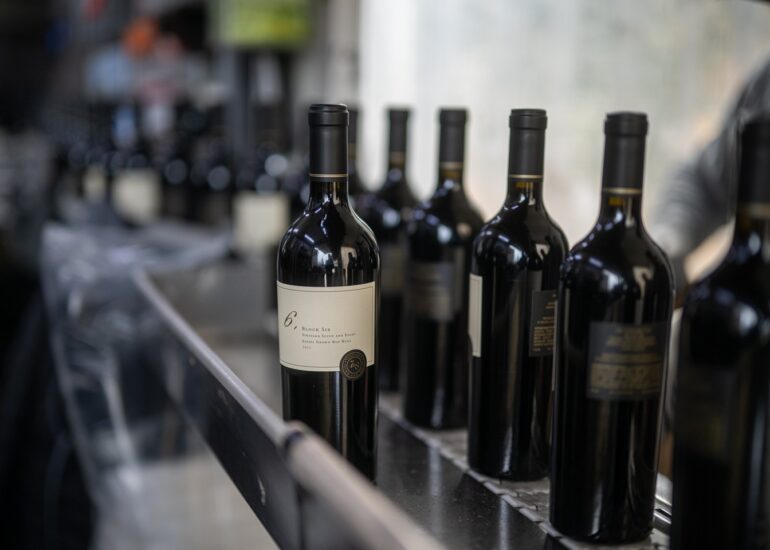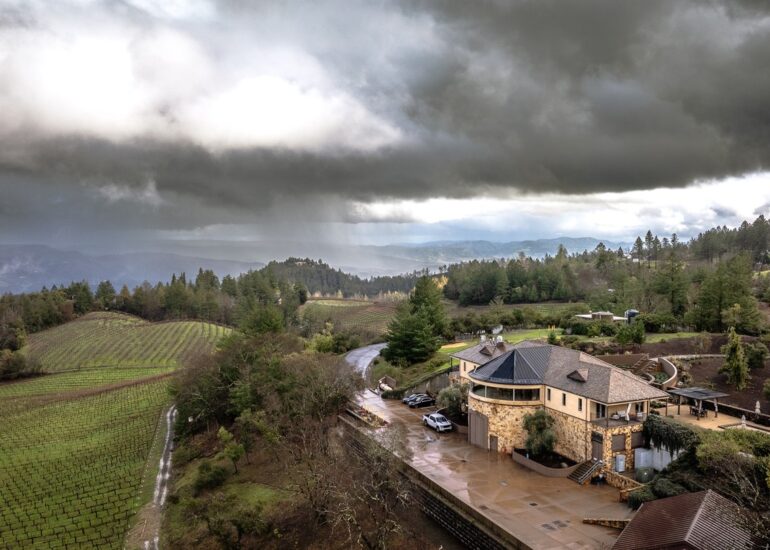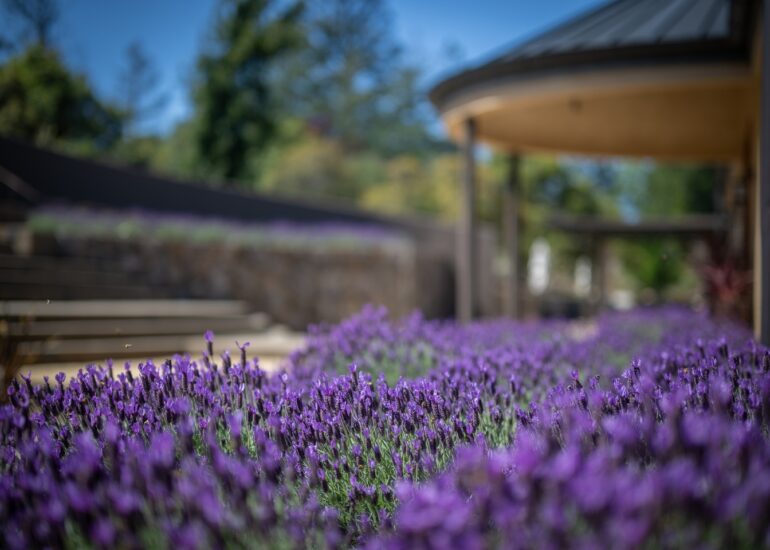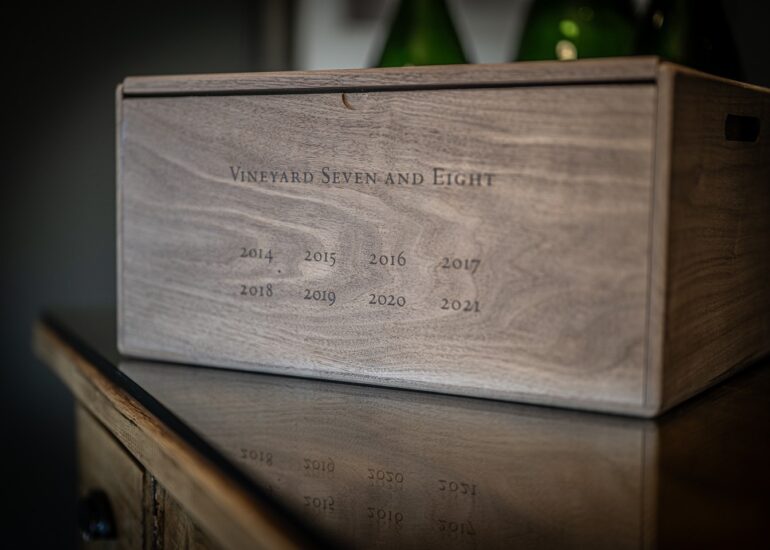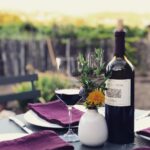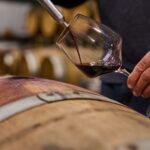Seven, Eight, Vine
Winemaker Interview
Seven, Eight, Vine
A conversation with Wesley Steffens and Luc Morlet of Napa's Vineyard 7 & 8
Newer Wine Brand Showcases Vineyards on Napa’s Spring Mountain
An Interview with the Estate Director and Winemaker of Vineyard 7 & 8
Vineyard 7 & 8 is a Napa Valley winery with a mission as straightforward as its name: to produce wines of exquisite quality that accurately reflect the small vineyards from which they hail at the top of Spring Mountain. But the simplicity ends there. For as any quality-driven producer knows, turning a vision into reality is only the beginning. More important is doing so in a way that balances technique and creativity with a sense of respect for the natural tendencies and rhythms of nature, ultimately allowing the vines to speak for themselves. As I learned during my lengthy conversation with general manager Wesley Steffens and his French-born winemaker Luc Morlet, the team at Vineyard 7 & 8 manages to strike that balance quite gracefully in the production of their fine wines.
Though initially one is met with what appears at a distance to be an almost understated facility that blends into the natural topography of Napa Valley’s Spring Mountain appellation, arriving on the Vineyard 7 & 8 property quickly reveals a spectacle of architecture and landscaping that’s nothing short of stunning. A closer look reveals that this beauty has brains, too, with its ultra-modern winery equipped with the latest and most sophisticated amenities that enable delicate handling and strict sorting of the fruit at harvest time, precise and constant control of every step in the fermentation process, and clinical cellar conditions that allow for the utmost in hygienic stringency. All of these permit the winemaking team to devote a great deal more of its attention to the artisanal process, directly contributing to the quality of its Chardonnay and Cabernet Sauvignon. Those wines are then aged in an equally magnificent subterranean cellar that doubles as a space in which to hold lavish events. It was both while touring the corridors of that state-of-art wine cave, and while joining them at the monolithic dining table in the chic rotunda just above it, that I spoke with Steffens and Morlet about the phenomenon that is Vineyard 7 & 8.
— Nikitas Magel
Following are edited excerpts from the interview. At the bottom of this post is the full recording.

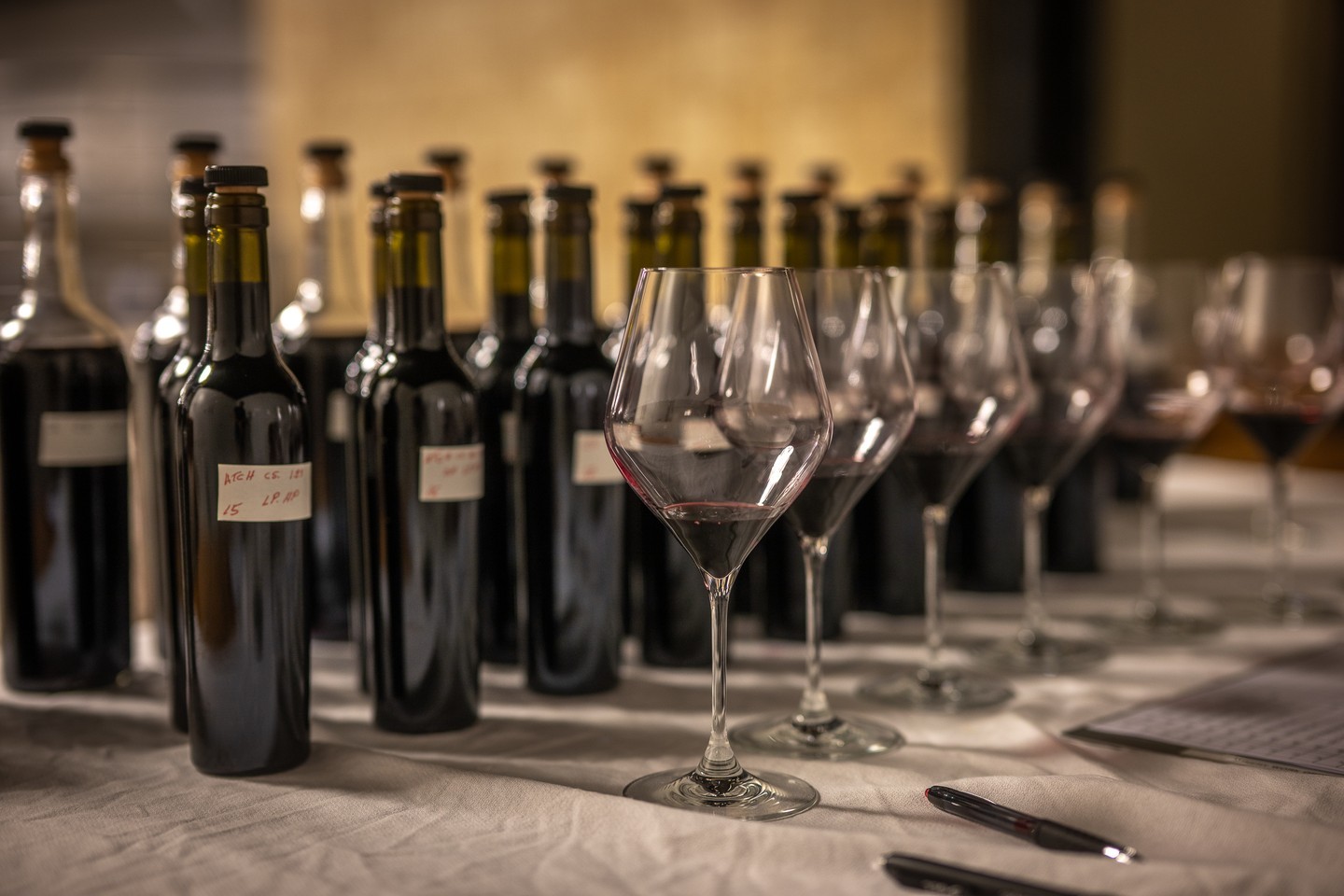
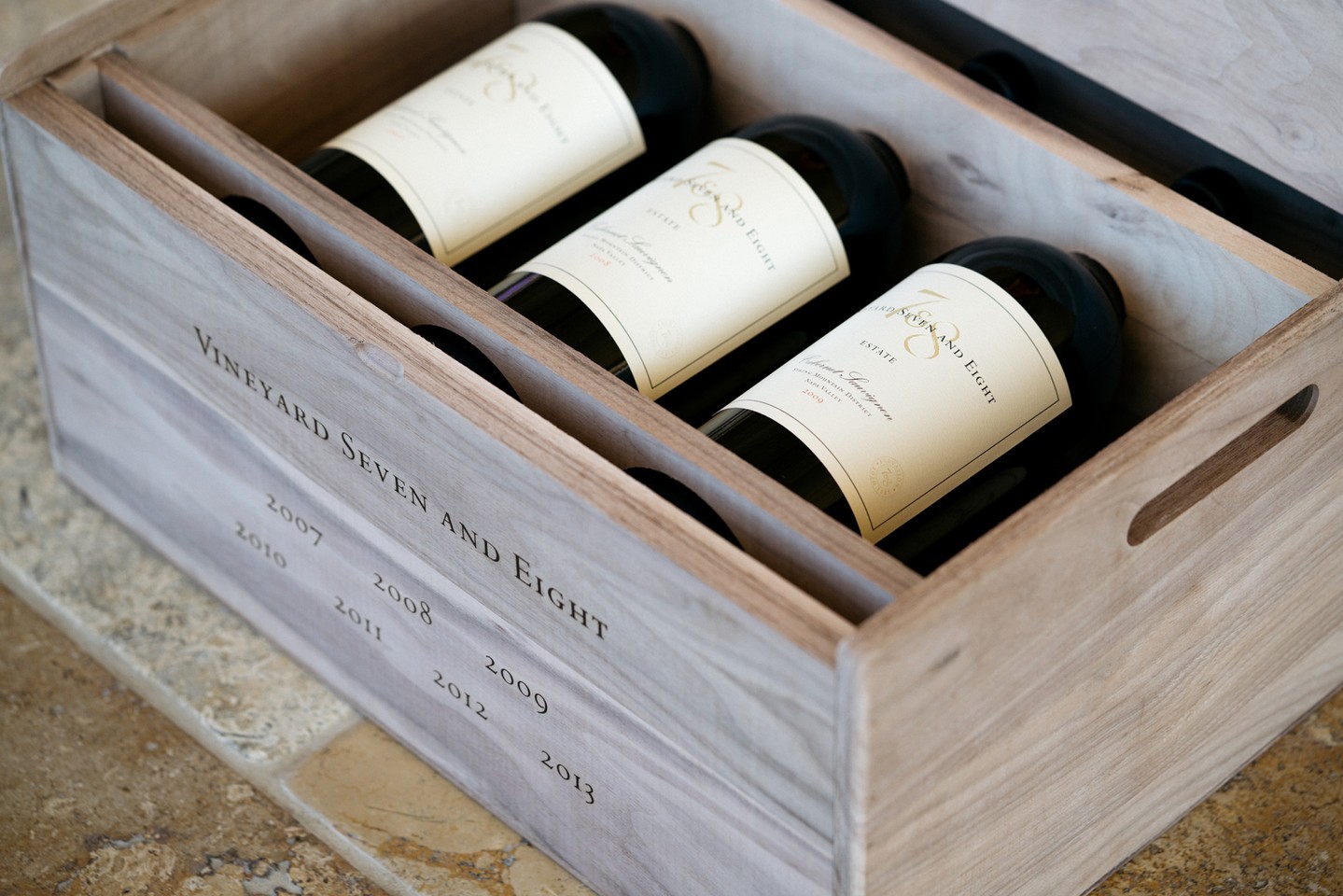
Adding Up the Numbers
Nikitas Magel: How did Vineyard 7 & 8 begin? Let’s start with the name; tell me about that!
WS: This was a project that my father started out of his passion for wine. His professional life has been in finance on Wall Street, which of course means he’s always been around numbers and has done a fair amount of business in the far east during his career. So, thinking in terms of numerology — 8 being a good luck number in eastern cultures and 7 being a good luck number in western cultures — those have always been his favorite numbers. When he found this property and learned it was planted to two varietals [Cabernet Sauvignon and Chardonnay], he figured, “Numbers are my life; why would I want my wines to be any different?” So the idea was to give that simplicity to the name of the wines. Also, there was a sense of humility to the fact that he wasn’t interested in calling by his own name; he wanted to do something special, but to do it in humble manner.
In the beginning, my father had a partner in the business that he met in San Francisco, someone who had basically supplied wines for his cellar and also sourced wines for some charity events that my father had done, including an annual AIDS dinner in New York City. He wanted to have special wines for those events, so he developed a relationship with this gentleman. It was he who got the ball rolling in helping us find this property, started the process of getting us branded and developing the name of 7 & 8, and did all the logistics business-wise to get the permits for building the winery. But his health hadn’t been so great. Plus, we felt that since we’re a family, we wanted to keep this as a family project. So, my father and his partner separated ways, and we took 100% control in 2006, which is when I came in to finish construction of the winery and begin to get operations of the business going.
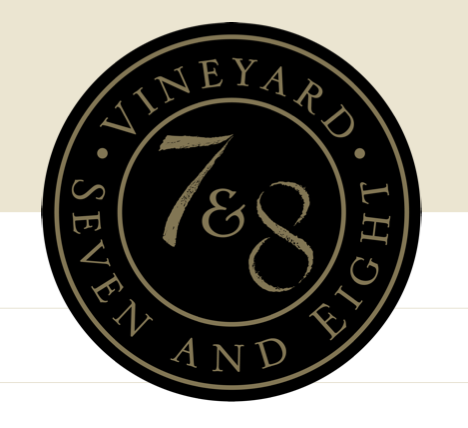
WS: So, while I manage the business on a daily basis, I also assist Luc in the winemaking. But we’re such a small team that we both also help Alyssa out with what she does with Sales and Hospitality, and she helps us in the cellar, too. We want to maintain the size we are, right about 1500-1800 cases of the current lineup. As we continue to develop our vineyards, we might grow to around 3000 cases, but not much more than that. We want to maintain that sense of being an artisan producer and don’t want to lose that ability to cross into each other’s worlds. It’s nice. The ability to go from working in the vineyard to working in the cellar to getting out on the road and meeting clients at the different events that we go to is important for the business structure that we’re trying to create.
NM: You have an interesting background that led you to this, beginning with your work as a chef and eventually a cellar rat…
WS: That’s right. After I graduated from college back east, I went to the Culinary Institute of America in Hyde Park, NY. While doing my studies there, I was lucky enough to get an internship at the French Laundry out here, where I spent about five months. When I went back to the CIA to finish the program, I kept in touch with Chef [Thomas] Keller and we maintained a great relationship. After finishing culinary school, he asked if I’d come back to his restaurant, which I did and then worked there for almost another year. Right about the same time, although I wasn’t directly involved in any of it, my family was starting to entertain the idea of constructing our own winery facility on this property. At that point, a winemaker buddy of mine asked if I’d thought about getting into the wine industry, especially given that my family had this project going. Since a couple of other chefs in the kitchen at the French Laundry were taking sabbaticals to learn about wine and really round out their training, I decided to do the same thing, but without any real intention as to where I was going to go from there (including no commitment to go work for my family).
So, I got a harvest position at Harlan [Estate]. The winemaker there, Bob Levy, told me at the time that he had space for me for only a couple of months, just for harvest, and that it was ‘bit of a demotion’ from what I was doing at the French Laundry, since I’d be dragging hoses and cleaning up the cellar. But I said, “Great! Sign me up! I’d love to see it all from the ground floor.” Long story, short, I shook his hand four year later and told him I felt it was time for me to go work for my family [at the new winery]. So, in retrospect, I definitely got a great experience there, seeing two vintages coming in as grapes and leaving as bottles. Starting as a harvest intern and leaving as their cellar master was an incredible education — it was my version of going to winemaking school, to learn on-hand with a producer like Harlan.
NM: And how did Vineyard 7 & 8 then evolve into a bona fide winery, with Luc as winemaker?
WS: After leaving Harlan, I came up here in 2006 to get thing going with the winery. I did one harvest with our team of two winemaking consultants who were here prior to Luc. One was a gentleman from France, Christian LeSommer, who had been the director of winemaking at Chateau Latour and then became an international consultant for some Lafite properties. He came on in the beginning stages. At that point, we really didn’t have a need for a full winemaking team; we were making our wines at Monticello Cellars in Napa, and they, of course, had their own winemaking team. Christian, along with our local winemaker, Larry Langbehn, were basically here to direct and ensure the team at Monticello was crafting the wines the way that we wanted. And so, after that first harvest in 2006 — a couple of days before which we completed construction on the winery — we sat down and discussed what our needs were and how we were going to proceed into the future. It was at that point that we decided we needed a full time, local winemaker here to make the day-to-day decisions necessary to take the wines to the next level. We had a couple of names in mind. When we were introduced to Luc, he presented some of the wines he made at Peter Michael, and then my father and I presented some of the wines that we’d previously made at 7 & 8. Then after talking, we realized our philosophies were right together and that this would work.

Focusing on the Vineyard
NM: Luc, what was it that attracted you to Vineyard 7 & 8? And had you worked with the Spring Mountain appellation prior to this?
LM: There were two main things. Coming from France about 15 years ago, there was no question that [in choosing where to work as a winemaker] the terroir, the location, was extremely important to me. But I learned over time that there is one other important factor: the people. And by ‘people,’ I mean the owners, their vision, their commitment, their efforts, and their staff. The Steffans family and I met through friends, through Harlan, really. And that showed me how serious they were, being connected with such a reputable producer. Then once I met with Wes, that did it. I would also say that I was attracted by the fact that we are from the same generation and we’re both ‘imports,’ so to speak — Wes is from the east coast, and I’m from another five thousand miles east of that!
Plus, it was very apparent that we both have a passion for quality and that we were in agreement from day one about the style of wine that we wanted to come out of this property. Sometimes people get into the industry with a ‘negative’ education, meaning that they’re going to be very scientific and then they start off with the wrong ideas. Wes started with the best schooling, really, by getting his hands dirty at Harlan, one of the best estates in California. That helped because, as a winemaker, I didn’t feel it was a battle each time I told him that we needed to invest in a piece of equipment or do something in the vineyards. We work hand in hand, basically. Then, later on, of course, I got to know the rest of the family and their point of reference, coming from having their own private cellars of great wines that they appreciate on a daily basis. After all that, I decided that this was the place I wanted to be; simple as that. So, again, it really is mainly about the location and the people, those are the two most important things — and from there, we can do anything!
As far as the terroir is concerned, I initially saw this site but had already had experience with Spring Mountain through my five years of work with Newton Vineyards, taking over from John Kongsgaard. Within those five years at Newton, I had gotten a great deal of experience with growers and maybe fifteen different appellations in both Napa and Sonoma counties. And that was my first experience with Spring Mountain. It’s a beautiful appellation, really — one that’s made up of a mosaic of soils because it had been broken apart by all the volcanic activity that occurred some millions of years ago. As a result, we see a lot of different types of soil, which is why I think the identity of Spring Mountain as an appellation is not always clear. Here, being on the ridge, the volcanic ash is really dominant — I love that because it gives a prominent minerality to the wine, which allows us to push the envelope and get real physiological ripeness without the risk of getting too much heaviness in the wine. It allows us to maintain an elegance and refinement to the wine because of that background of rock, that minerality. And so that, for me, was how terroir was the number one reason I wanted to work here.
NM: Clearly, then, you have a liking for Spring Mountain as an appellation. Can you say more about that?
LM: I think this is a really neat part of the valley. Spring Mountain tends to be more sheltered because we start to get shade late in the afternoon. So, just when the vines get tired from being in the heat and sun all day long, the shade comes and they get to breathe. We also have a cooler influence with the elevation, which extends the ripening season — we generally pick the Chardonnay around September and the reds around October. Personally, I prefer to see a vineyard that’s green, as in Europe, rather than in desert-like conditions, which to me seems artificial since, without irrigation in that environment, you can’t do much at all. That’s why I generally prefer Spring Mountain to some other parts of the valley. On the other hand, the other Mayacamas mountains [here on the western side of the valley] I feel have a much cooler climate, so it gets perhaps too cool for the type of varietals we grow and the style we’re going for. But over here, we have a sweet spot.

NM: So, the vines naturally struggle up here, which itself helps to produce more concentrated and nuanced fruit. But tell me about what you’re doing in the vineyard to maximize the potential of that fruit.
LM: We do really detailed work throughout the year in an effort to keep the vines at an optimal balance between the fruit and the canopy, so we get vines that have some vigor but not too much. The result, ideally, is that by August, when veraison occurs, the fruit has good aeration — by removing the laterals and some leaves on the east side, we get a nice movement of air that lessens pest pressure and allows us to use fewer pesticides. With that, we also get fruit that ripens more evenly, so won’t see one cluster that’s still green yet another that’s red or even ready to be picked. We work to be very consistent from vine to vine, and also within each vine itself. When it comes time to harvest, we pick based on taste, exclusively. We also do so entirely by hand, by individual blocks and in waves. So, within a single block there might be three or four different pickings. The fruit is placed in small 30-pound lugs [as opposed to the more common 1/2 ton macro bins], which we stack on plastic palettes that are then brought back on special trailers. And we bring the fruit into the winery right away after picking very early in the morning.
Details in the Cellar
NM: I’m guessing that, by virtue of their smaller size and lighter weight, these lugs that you’re using are not only easier on the harvest workers, but gentler on the grapes?
WS: Absolutely. Using them is as if you went out into the vineyard, cut a cluster off, and then hand-delivered it to the winery.
LM: When we unload those lugs, full of grapes, onto the sorting table, we don’t see a single drop of juice! It’s entirely whole berries, whole clusters.
WS: And that’s how they are when they go into the fermentation tank — with the berries still whole. We’ll have selected out all bits of the stems or impurities plus any underripe or overripe fruit. That gives the ability to achieve in the wine the true flavor of the ripest and best tasting fruit. We might leave in just a little bit of the shriveled fruit, to give us some complexity and some of the ripe black fruit qualities…
LM: …but, of course, get rid of the raisins. Because those increase first the sugar and then the alcohol, and they have a baked flavor. I think overall, as a winemaker, the challenge — the welcome challenge, I have to say — has been to make wines that can age beautifully for decades, yet are approachable within a year or two of their release. I think that by having the luxury and taking the effort of removing all the little things that would impart a greenness or bitterness or harshness to the wines, we can make those wines really shine right away — yet they maintain the concentration, depth, and texture that will allow them to age beautifully.

NM: So, it sounds like you’re very stringent and conscientious in the procedures you take at the very beginning of the winemaking process, even before fermentation begins. But how about towards the end of the process, in putting together the final blends, when I’m guessing there’s less protocol involved and more artisanal interpretation?
WS: Luc and I sit down multiple times a year to taste the wines, at a table setting so we’re removed from the cave to really properly evaluate the wine. When we sit down for a blending session, it’s broken down not only by lot (by the tank that it was in), but by barrel producer as well. So, we’ll have as many as 30 to 40 samples of wine on the table to give us a true evaluation of the wines. It’s a process of trial and error that we’ll go through a number of times, trying the different wines together and gradually deciding what will eventually make up the blends that we create for both the Estate Cabernet and the [non-estate] “7” Cabernet. Anything that doesn’t make it a final blend, we declassify and sell to the secondary market.
WS: (con’d) The most important thing about that process is that we don’t have a set number of cases [of wine] that we feel we need to produce. That’s important because having such a goal would bias our decision-making, since we might feel pressured to use wines in the final blend [to meet a certain case-production number] that might not otherwise meet our standard of quality. Without the expectation of producing a certain number of cases, we’re focused entirely on the quality of the wine. In some years we’ve made only 600 cases of our estate wine. There’s no saying that next year we may make only 500 cases. And that fluctuation is based not only on vintage variation but also in making sure that we’re selecting only the absolute best barrels for both wines.
LM: It’s a very selective approach. We start with the Estate Cabernet, which is blended from the very top wines of the estate. Then we build a second wine from wines that almost made the cut [for the Estate Cabernet] but not quite (because, for example, the vines might be too young). Everything else that we’re not happy with gets sold off. That way, we feel very comfortable with the product we’re putting out in the market. And of course, in terms of marketing, it’s much easier for us as a winery to sell a small number of cases of excellent wine rather than large amounts of wine that, while still good, would be somewhat ordinary.
NM: Are the decisions you’re making on what goes in the final blends based entirely on the vineyard source?
WS: The estate wine, of course, is all estate fruit. Even as our younger [estate] vines start to produce, the fruit from them isn’t going to go immediately into the estate wines…
LM: But to be fair to these newer blocks — because they are planted with what we think is the right spacing, the best rootstock, and best clones — what we do during our blending trials is that we taste blind. That’s because we want to give a chance for these younger vines to prove themselves. In the ’07 and ’08 vintages, there were a few lots that didn’t qualify the year before, whereas this year they will qualify. So, really, in the end, “In Vino Veritas.”

WS: And there could be fruit that we get from the estate that doesn’t classify for anything, and the same thing with the fruit from our growers. While the estate wine is our flagship, using fruit from our property, that doesn’t mean we don’t give the same care and attention to the “7” Cabernet that we make from the growers. Not being grown on our site is really the only reason the wines from that fruit are not considered ‘estate.’ But we’ve selected those growers with the same philosophy and same standards that we use for the fruit we grow here — the best clones, the best rootstocks, the best soil characteristics. And if we’re going to have a new grower, we give them a try for a couple of years; if it doesn’t work, we go for another grower. So the growers we currently work with, we know their fruit and its history, having chosen it because we think it’s the best quality that we can get.
LM: To give a fair picture of the selection process, this is all really just to say that we won’t be cheap by trying to make use of a few barrels [of finished, pre-blended wine] if the quality is not there. But the majority of barrels, of course, we’re happy with; it’s only a small percentage that ends up leaving. When it does happen, most of the time it’s because of the cooper. So, we do a barrel-for-barrel tasting, as well, to make sure that everything is okay.
One of the techniques that I love to use is that we taste the barrels before using them, to get them ready [before aging the wines] — and very few winemakers actually do that. That’s one way to discriminate for quality. Of course there’s a visual inspection of the barrels; any good winemaker would do that. But a tasting of barrels is something that’s quite different and good for us to exercise, so that down the road we don’t have any major surprises.
Enumerating Quality Elements
NM: Comparing the two Cabernets the “7” Cabernet and the Estate Cabernet — I definitely taste a common thread running through them, which I’m guessing is a factor of the appellation and the site specificity. The “7” is readier drinking, with a brighter and more expressive profile, and overall more nicely integrated, but with somewhat more assertive tannins. Other than that, how would you characterize the nature and age of the respective vines for your two Cabernets?
WS: Our Cabernet vines were planted in ’82-’83, so we’re talking 25 years of age on our vineyard. And that clearly shows in the concentration of fruit that we get in the wines. On the fruit that we purchase, I think that the vines are a bit younger. But with the “7” Cabernet [made from that purchased fruit] showing more vibrant fruit right now, the stylistic choice we made was for that wine to be the younger brother, so to speak, to the Estate Cabernet. The “7” Cabernet has the youthful energy and firmer tannins that you’d expect from a younger wine. Whereas the Estate Cabernet has greater concentration and finer-grained tannins, along with a structure and mid-palate that you’d expect from more mature vines, plus an overall more harmonious balance where no single component of the wine is showing over another.

LM: Significant to the blending process is the quality of the tannins and their evolution over time. The main wine — the grand vin, as it’s called in Bordeaux — might, at an earlier age, feel a bit more austere. But we know that after a year of bottle age and over another decade or two, it’s clearly the wine that can gracefully manage time. The second wine is almost there, but not quite. On the Estate wine, there’s some astringency — but it’s astringent from beginning to end. Whereas on the “7” Cabernet, there’s initially a roundness and smoothness that makes it more appealing at first, but then on the finish you get an astringency that comes not just from the fact that the tannins are young, but because their quality is not quite as fine. Between the two, there’s only a subtle difference in quality. Otherwise, if there’s something we don’t really like about a blending component, it simply would not go under the Vineyard 7 & 8 label; we’d just break it out. Some people might expect a bigger difference of quality — but that’s not the case; it’s subtle.
WS: We could have easily had just said that we’re going to work solely with the estate fruit because we think that the fruit that we’re selecting for the estate wine is the best that we can grow on our property, and really highlight an estate wine from an estate facility. But the fruit that we’ve gotten and worked with from the growers on Spring Mountain has been to a quality level quite comparable to the fruit that we grow here…
LM: For some of them, we’ve actually taken over the farming. And most of them are neighbors, really.
NM: So, the “7” Cabernet is really not conceptually a ‘second’ wine, in the sense of being a step down in quality from the ‘grand vin.’ In fact, it’s very much in keeping with the terroir of this very specific location and elevation on Spring Mountain. To have access to fruit from other vineyard sources that’s so similar to your own is quite a luxury to have!
WS: Yeah, and that’s why it’s hard to call it a ‘second’ wine, because it’s not in the traditional definition of a ‘second’ wine — we’re not saying that it’s of lesser quality. Rather, it’s a wine that reflects the relationships we have with our neighbors.
NM: In a sense, you’re a spokesman for these growers whose fruit your source, because you are very closely representing their own site, their own terroir.
LM: We see them pretty much every day. And they actually come to the winery to taste the wines, too.
NM: Focusing now on the “8” Chardonnay, I have to say it’s very striking in how well it’s balanced in its bright fruit profile that’s also elegantly round on the palate. There are very few New World Chardonnays that I personally like because I find they’re often at one extreme or the other: a great deal are overly round and creamy, stripped of the grape’s natural verve as a result of heavy-handed malolactic, and others — ostensibly made in an effort to overcompensate for that trend — that are awkwardly lean and devoid of breadth. Striking a balance is where the beauty of Chardonnay lies.
WS: Interestingly, our Chardonnay goes through 100% malolactic, but it doesn’t have any of those buttery qualities.
LM: And that’s because it’s made with natural flora. What some wineries do is to innoculate their Chardonnay with a strain of [malolactic] bacteria that is known to create a lot of diacetyl. But by using the natural flora and being very clean in the cellar, our malolactic fermentation occurs spontaneously. And instead of taking just a week, as with some of the strong buttery strains, this one might take a month, sometimes two months, to complete the process. And that creates more complexity. It doesn’t just turn the malic into lactic acid plus diacetyl; rather, it creates some other bi-products that actually enhance the quality of the wine and ultimately create much less diacetyl, and therefore less of that buttered popcorn flavor. And so allowing the wine to go through 100% malolactic with no intervention makes a wine that’s very stable. No fining or filtration is needed. If there happens to be a bit of yeast or bacteria left, so be it — that’s not necessarily a bad thing because there’s nothing left [for the yeast or bacteria] to consume; the sugar is all gone and malic acid is gone as well. And so, because the wine is stable, we don’t need to add much sulfur [dioxide], other than a very small amount so that nothing will oxidize.
Texture is another thing that I personally focus on, so that we have a real expression of the vineyard. These vines were planted fifteen years ago, so they have some depth. When you taste the wine, you can tell that it’s not just a simple expression of the varietal; it has some other characteristics. The texture is really important, because it makes the mouthfeel and allows everything else to be well-integrated — the oak, the alcohol, etcetera — so that when we taste it, it’s not easy to differentiate the individual components of the wine. It makes the entire experience harmonious and seamless. And that’s what I personally enjoy! So, overall, intensity and complexity are my automatic objectives, then my secondary focus is on texture.
Summing It All Up
NM: My sense is that achieving the seamlessness you’ve just described is one of the most challenging aspects of winemaking. It’s where the true artisanship comes in and wherein purely technical training fails to master: to make a wine whose profile is so smooth and graceful that one component melds into another, which in turn melds into yet another — so that the taster cannot pick out any one of them because it’s so well integrated with all the others. I feel that’s where the real magic lies in a well-made wine.
WS: Education becomes a base, but you’ve got to build on top of that with the artisanal side, with your own creativity, with your own footprint. For me, culinary school is what brought me into the wine industry. One of the things that was taught to us there is that you learn the simple techniques and building blocks, which should spring you into whichever direction or type of food you ultimately want to create. And though I didn’t go to classical winemaking school, other than some courses, I’m sure it’s the same idea with wine: you learn the science behind it, but that only gets you so far in terms of what you’re trying to create with your wine and really giving it your own sense of yourself and your interpretation of the vineyard.
LM: Aside from the issue of science vs. artisanship in winemaking, another really important facet of this job is clearly farming. Nature has the last word, every time. Despite all the science and artistry, we are still limited to some degree. On the one hand, for instance, some growing seasons are more challenging than others; conversely, others are quite wonderful because they express things that we simply could not, through science or artistry alone.

LM: (con’d) That’s where it’s so important for our approach to allow things to be as they are. Sure, we’ll use to science to understand what’s really going on (with the fermentation process, for example), and we will use artistry to make decisions on the final blends. But otherwise, this is all more about being humble and letting the vineyard speak for itself. Then, of course, we can direct things a bit by using different cuvées, especially with our reds. But nature really has the last word; and that’s the beauty of the industry, the beauty of our job.
All the more beautiful is how the team at Vineyard 7 & 8 have managed to strike a sense of balance, both in the vineyard and in the cellar. Knowing when and how to facilitate the grapegrowing and winemaking processes, all while showcasing the terroir of their own estate and of neighboring vineyards on Spring Mountain, is a skill as elegant and graceful as the wines themselves of Vineyard 7 & 8. To learn more about this producer and its portfolio of wines, visit Vineyard 7 & 8 online.
Interview by Nikitas Magel
Photos by Vineyard 7 & 8

Comments are closed.

